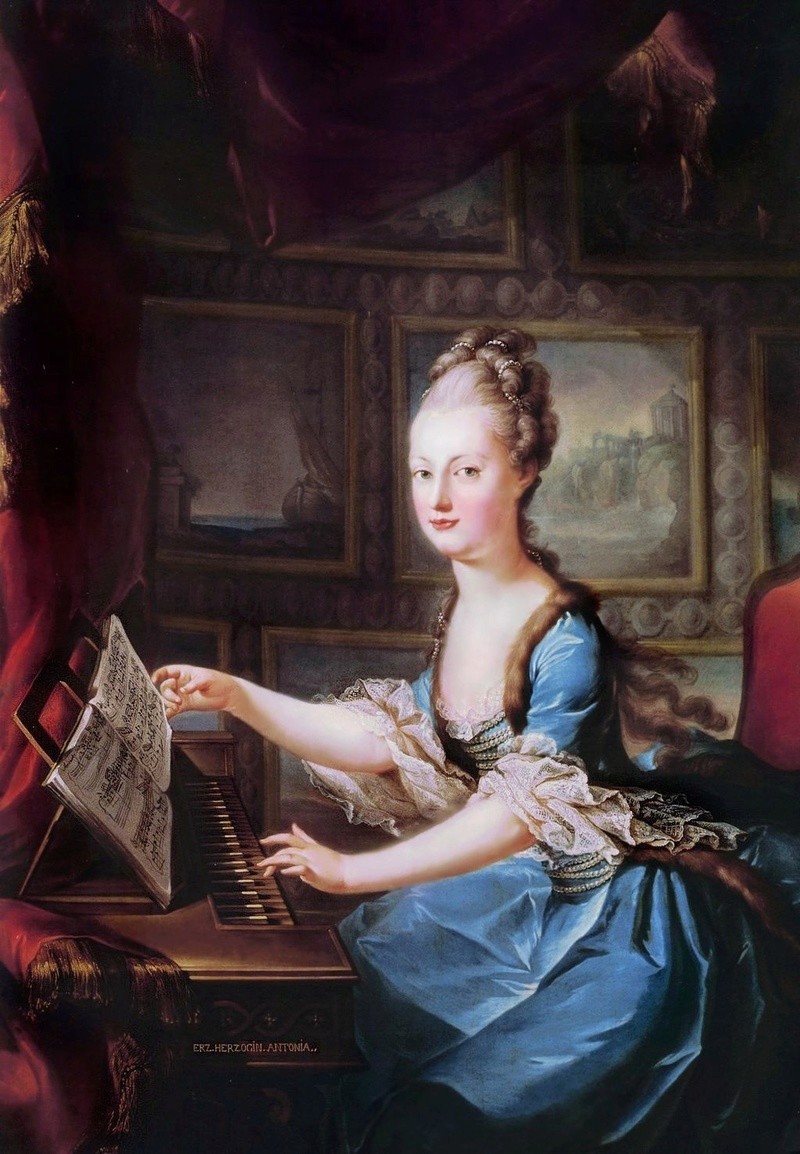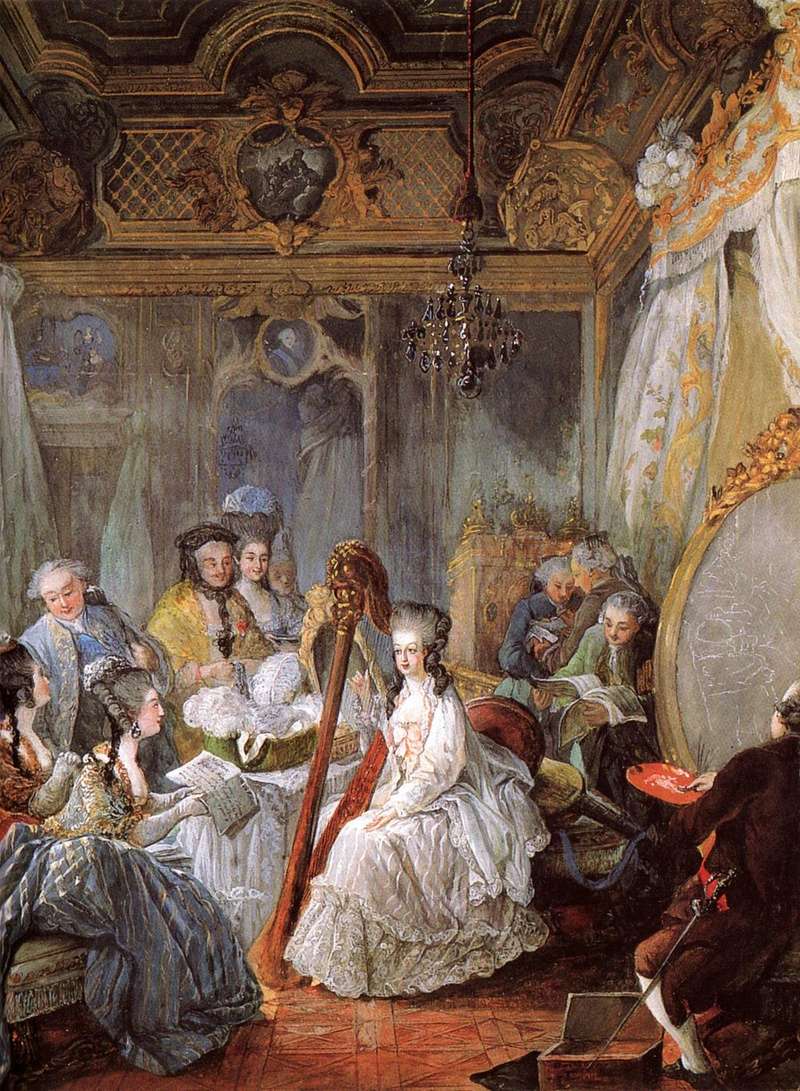Marie Antoinette and music grande passion


Whilst musical talent in the eighteenth century was judged to be an appropriate feminine accomplishment, Marie Antoinette’s personal relationship with music was a special one, which reached far beyond mere natural inclination. Music proved to be in many ways, perpetually present, like a main character in her life story, giving parallel to key events or lending them at least, poignant expression. Her love and patronage of the music of the composer Christoph Willibald Glück, whose works she did much to promote in France, reaches back even further than Marie Antoinette’s birth, because the composer’s official inauguration in the role of composer of “theatrical and chamber music” took place in 1755 at a court ball at the summer palace of Laxenburg, when her mother, Maria Theresia, was roughly three months pregnant with her, the Empress’s fifteenth child.
When Archduchess Maria Antonia (“Antoine”) of Austria, the future Marie Antoinette was recorded as singing a French song as early as three-years-old, for the name day of her father, the Holy Roman Emperor Franz I, in 1759. She also met the young Wolfgang Amadeus Mozart, who gave his first concert at Schönbrunn Palace, the magnificent Habsburg summer residence on the outskirts of Vienna, in 1762, in the presence of the Empress and the Imperial Family, with the boy prodigy from Salzburg performing on the harpsichord. As Austrian Archduchess, Marie Antoinette’s young love of music was expressed in the painting of her at the spinet by Franz Xaver Wagenschön, a delightful image now part of the Kunsthistorisches Museum collections. The art is arresting, showing Marie Antoinette poised to turn the pages of her music, with one hand delicately resting on the keys. She is dressed in a day dress of blue satin, trimmed with fur, possibly of sable. It is proof, in any was needed, of her early commitment to what would be, a lifelong relationship.

rchduchess Maria Antonia, by Franz Xaver Wagenschön
(Franz Xaver Wagenschön [United States Public domain], via Wikimedia Commons)
Even allowing for flattery when stressing the accomplishments of Austrian archduchesses – bearing in mind the future that was envisaged for them on the European chessboard of political, royal marriages – Marie Antoinette’s gift for music was both obvious and needed no exaggeration. As Archduchess, she sight-read to a professional level (Antonia Fraser, Marie Antoinette: The Journey, Pg 24, 2000). She was in addition to all this, a dancer par excellence. The young Archduchesses were taught by the court composers Glück and Wagenseil, and also by Joseph Stephen and Johann Adolph Hasse. Two Englishwomen, the Davies sisters, were particularly talented with ‘musical glass’ but also, the harpsichord, and taught the Austrian Archduchesses. The ballet portrait of ‘Il Trionfo d’Amore’ – the performance in which Marie Antoinette participated as a shepherdess for the wedding of her brother, Archduke Joseph and Princess Josepha of Bavaria in 1765 – demonstrates again, her deep love of music and dancing; a version of it later belonged to her in France – now displayed, appropriately, in her beloved private retreat, the Petit Trianon. Marie Antoinette was, in fact, taught ballet by the French ballet master, Jean-Georges Noverre. The ballet portrait hints at the extreme poise of Marie Antoinette’s bearing, with her long neck, so well captured in sculpture, already evident.
It was fitting perhaps, that Marie Antoinette’s favourite musical instrument should be one that entirely supports this view of both classical elegance, but also supreme grace – the harp. She received instruction from her gifted teacher, Joseph Hinner (Ibid, 2000). The artist Jean-Baptiste Gautier-d’Agoty painted Marie Antoinette at Versailles, a picture which survives in the Chateau’s collections, depicting her in her bedroom playing the harp. This was an instrument which again, does good justice to her famously long neck. Marie Antoinette appears to be about to play the instrument or to have momentarily paused, whilst a singer holds out to her the manuscript of the music and Gautier-d’Agoty includes an artist painting the scene as if observing it through double vision. Marie Antoinette received Glück in her Private Cabinet at Versailles. Fittingly, a harp is today displayed in this small, same apartment. A harpsichord and harp are somewhat touchingly, also showed at the Petit Trianon today, in the Company Room – proof of a personal interest in a private haven.

Marie Antoinette playing the harp at the French Court, by Gautier-d’Agoty
(Jean-Baptiste André Gautier-Dagoty [United States Public domain], via Wikimedia Commons)
Marie Antoinette encouraged Glück’s work, supporting his 1770s operas, Alceste and Armide faithfully, as she had stood by Iphigenie en Aulide and of course, Orphee, with its legendary ‘J’ai perdu mon Eurydice’. In a pleasing parallel with the composer having been associated with her mother’s pregnancy in 1755, Glück was allowed to go to France during Marie Antoinette’s pregnancy in 1778, the child who would be Marie Therese, the future Madame Royale.
Versailles, of course, enjoyed its own considerable musical legacy, left by the composers patronised by Louis XIV, such as Rameau and of course, Lully, the King’s opera director. Versailles’ Opera was not built during the Sun King’s reign, however, and only inaugurated in 1770, after Marie Antoinette’s marriage to the Dauphin. The fabled Colonnade groves at Versailles had been popular places for ballet or musical entertainment during the reign of Louis XIV.
Marie Antoinette’s library at Versailles included French music, but also the work of the Italian composer, Piccinni (Ibid, Pg 135). An opera by Rameau was given on the occasion of Marie Antoinette’s wedding to the Dauphin Louis Auguste; Candeille’s Castor et Pollux was performed for the then Louis XVI and Queen Marie Antoinette, not long before their departure from the Tuileries in 1791.
Interestingly, Wolfgang Amadeus Mozart, the child genius whom she had first encountered as a young Archduchess at Schönbrunn, returned to Paris in 1778, on another fruitless search for royal patronage. This was a disastrous journey as it would turn out, which also resulted in the death of his mother, Maria Anna Mozart. During the time that he was in Paris, however, Marie Antoinette was again pregnant, and Mozart’s mother took an interest in news of the pregnancy of the Austrian-born French Queen, whom she must have remembered from the Vienna performance of 1762.
There is a sad, poignant epilogue to all this. Marie Antoinette was held in the Conciergerie in Paris, in the months leading up to her execution. We are grateful for the recollections of Rosalie Lamorliere, a servant-girl in the prison between August and October 1793, who became devoted to the deposed French Queen in captivity, because it is thanks to these recollections – dictated in old age – that we have first-hand descriptions, rich in psychological detail, of Marie Antoinette’s final months. One of these descriptions shows that Marie Antoinette’s love of music never left her, not even in prison – following the agonising separation from her children and the execution of Louis XVI. On one occasion in the Conciergerie, she heard the music of a harp being played and looked up instinctively; poignantly, it was the daughter of a glazier, who was repairing the windows of her cell (Ibid, Pg 503).
It was a long way from the music of Glück and the portrait by Gautier-d’Agoty, showing her plucking at a harp, in her bedroom in Versailles.

Elizabeth Jane Timms, 2018
http://royalcentral.co.uk/blogs/marie-antoinette-and-music-100569
